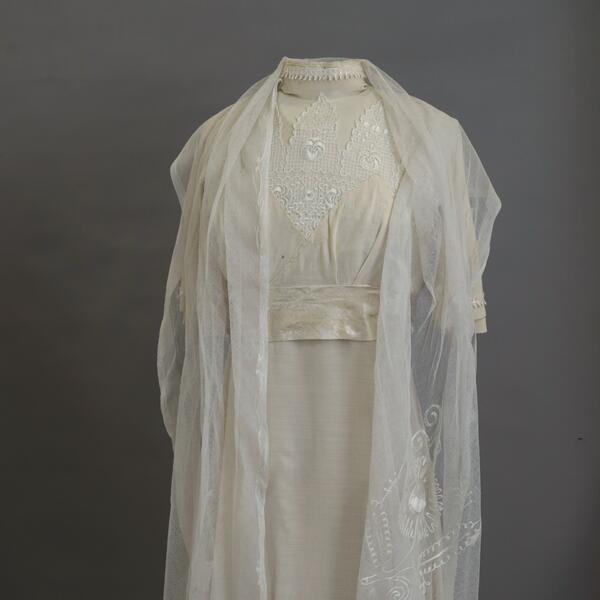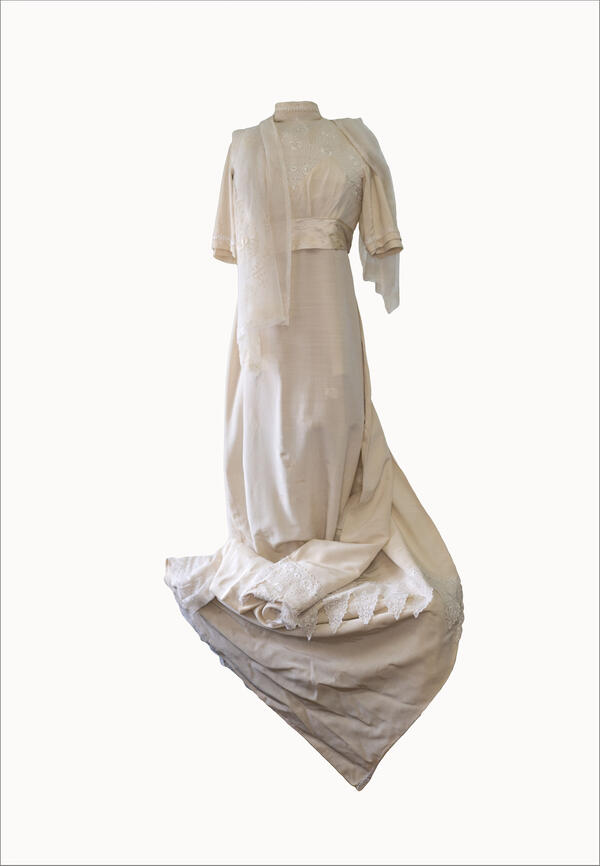On December 14, 1825, the Decembrist Revolt took place at Senate Square in Saint Petersburg. In July 1826, a trial was held, and Vasily Ivashev was initially sentenced to 20 years of hard labor, after which he was to settle in Siberia for the rest of his life. A month later, his sentence was changed to 15 years. Camille Le Dentu decided to support her beloved and follow him. In 1931, she went to Siberia after a lengthy process of obtaining necessary permissions, including that of His Imperial Majesty.
Wedding dresses of the 19th — early 20th centuries were mostly high-necked with semi-long or long sleeves — not at all like evening gowns but still elegant. There was no established wedding fashion: dresses were sewn from fabrics of white color or other light shades according to the fashion that was relevant at the time of the wedding. The bride’s hairstyle had to match the fashionable silhouette of the dress.
The wedding dress from the collection of the Decembrists House Museum was worn by a teacher named Tatyana Ilyinichna Burdukova from the village of Bor, Korkinsky volost. According to the “Extract from the register of marriages”, the 21-year-old Orthodox woman married Porfiry Dmitriyevich Vetoshkin, a 26-year-old peasant teacher, in the Annunciation Church of the Turinsk district on November 20, 1913. The happiness of the newlyweds was short-lived: the First World War was about to start, followed by the Russian Civil War, where, six years after the wedding, the young father and husband Porfiry Vetoshkin died a hero’s death. Tatyana never remarried. She worked hard and raised her daughter alone.
The wedding dress is made of shantung silk, a rather dense fabric made of wild silk with a special texture, which is obtained due to the uneven thickness of the threads. The fabric itself is of a soft cream or light beige shade with a slight sheen. It maintains the perfect body temperature in every weather. The dress feels nice to the touch, the fabric is not dyed and has its natural color. The wedding garment is richly decorated with thin, elegant lace in the Vologda style.
Wedding dresses of the 19th — early 20th centuries were mostly high-necked with semi-long or long sleeves — not at all like evening gowns but still elegant. There was no established wedding fashion: dresses were sewn from fabrics of white color or other light shades according to the fashion that was relevant at the time of the wedding. The bride’s hairstyle had to match the fashionable silhouette of the dress.
The wedding dress from the collection of the Decembrists House Museum was worn by a teacher named Tatyana Ilyinichna Burdukova from the village of Bor, Korkinsky volost. According to the “Extract from the register of marriages”, the 21-year-old Orthodox woman married Porfiry Dmitriyevich Vetoshkin, a 26-year-old peasant teacher, in the Annunciation Church of the Turinsk district on November 20, 1913. The happiness of the newlyweds was short-lived: the First World War was about to start, followed by the Russian Civil War, where, six years after the wedding, the young father and husband Porfiry Vetoshkin died a hero’s death. Tatyana never remarried. She worked hard and raised her daughter alone.
The wedding dress is made of shantung silk, a rather dense fabric made of wild silk with a special texture, which is obtained due to the uneven thickness of the threads. The fabric itself is of a soft cream or light beige shade with a slight sheen. It maintains the perfect body temperature in every weather. The dress feels nice to the touch, the fabric is not dyed and has its natural color. The wedding garment is richly decorated with thin, elegant lace in the Vologda style.




